Disruptive Innovation Theory and Application Report
VerifiedAdded on 2022/12/13
|12
|3820
|249
Report
AI Summary
This report provides a comprehensive overview of disruptive innovation theory, a critical concept in business development. It begins by defining managing innovation and introduces the disruptive innovation model, emphasizing how smaller companies can challenge established market leaders. The main body delves into the core principles of disruptive innovation, including targeting underserved markets, understanding customer needs, and employing emergent strategies. It outlines the process of disruptive innovation, from initial market entry to market dominance, and discusses the benefits for both consumers and companies, such as innovative products and opportunities for startups. The report also addresses the limitations of the theory, such as the need for a distinct strategy and the difficulty in achieving initial profits. Furthermore, it includes a case study of Hello Fresh, illustrating how the company has applied disruptive innovation to revolutionize the meal kit industry, examining the company's mission, vision, and business model. The report concludes by summarizing the key takeaways and implications of disruptive innovation in the current business landscape.
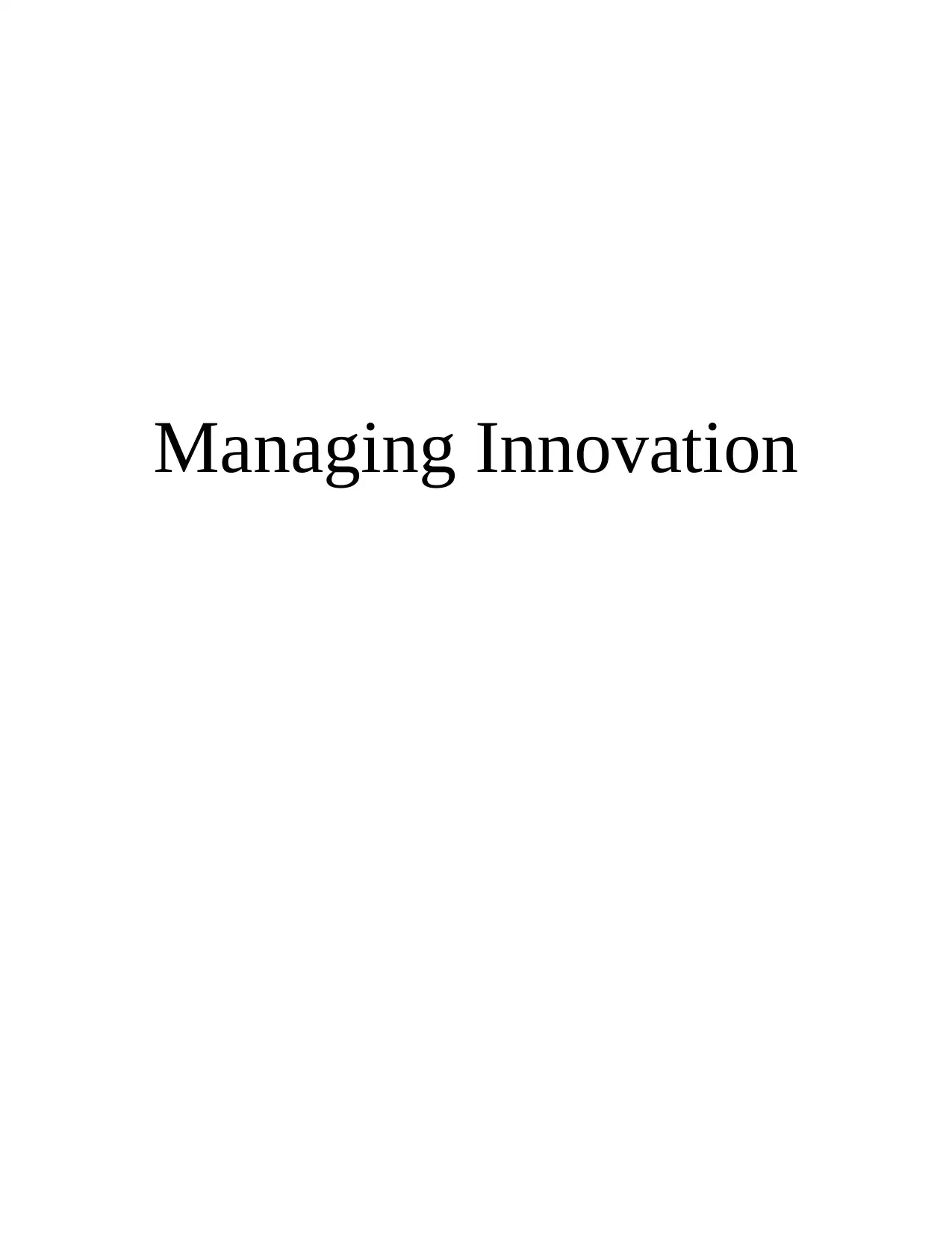
Managing Innovation
Paraphrase This Document
Need a fresh take? Get an instant paraphrase of this document with our AI Paraphraser
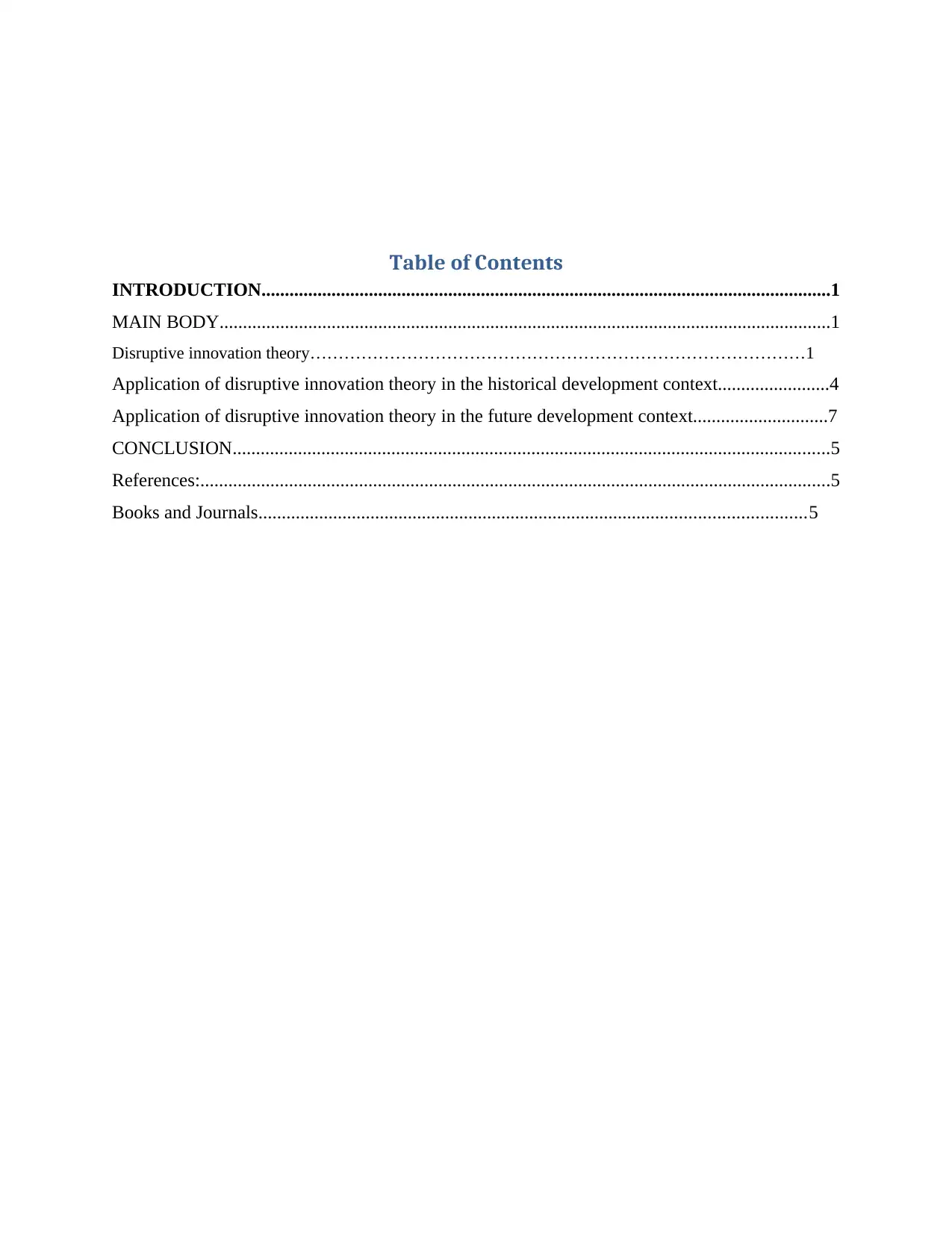
Table of Contents
INTRODUCTION..........................................................................................................................1
MAIN BODY...................................................................................................................................1
Disruptive innovation theory……………………………………………………………………………1
Application of disruptive innovation theory in the historical development context........................4
Application of disruptive innovation theory in the future development context.............................7
CONCLUSION................................................................................................................................5
References:.......................................................................................................................................5
Books and Journals.....................................................................................................................5
INTRODUCTION..........................................................................................................................1
MAIN BODY...................................................................................................................................1
Disruptive innovation theory……………………………………………………………………………1
Application of disruptive innovation theory in the historical development context........................4
Application of disruptive innovation theory in the future development context.............................7
CONCLUSION................................................................................................................................5
References:.......................................................................................................................................5
Books and Journals.....................................................................................................................5
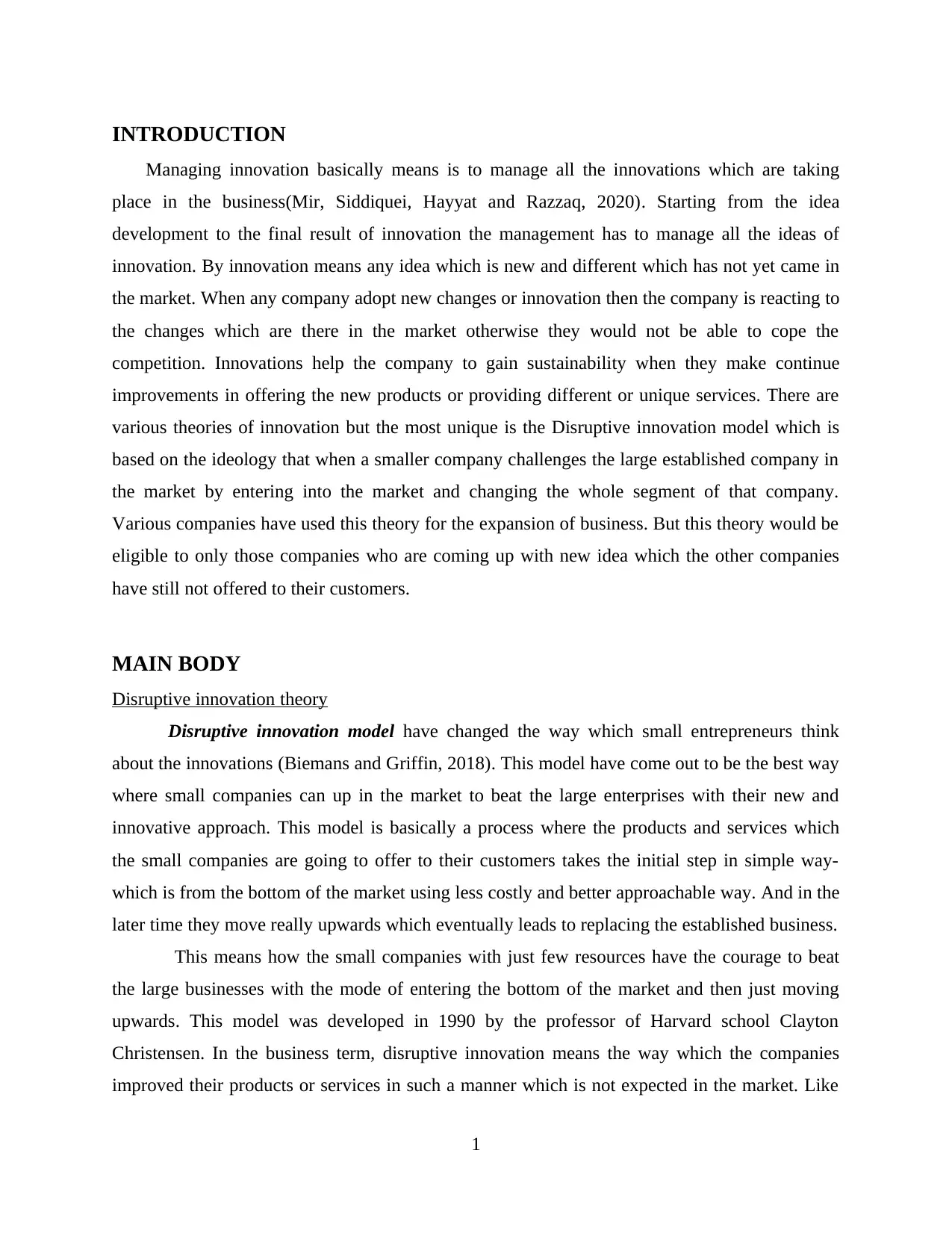
INTRODUCTION
Managing innovation basically means is to manage all the innovations which are taking
place in the business(Mir, Siddiquei, Hayyat and Razzaq, 2020). Starting from the idea
development to the final result of innovation the management has to manage all the ideas of
innovation. By innovation means any idea which is new and different which has not yet came in
the market. When any company adopt new changes or innovation then the company is reacting to
the changes which are there in the market otherwise they would not be able to cope the
competition. Innovations help the company to gain sustainability when they make continue
improvements in offering the new products or providing different or unique services. There are
various theories of innovation but the most unique is the Disruptive innovation model which is
based on the ideology that when a smaller company challenges the large established company in
the market by entering into the market and changing the whole segment of that company.
Various companies have used this theory for the expansion of business. But this theory would be
eligible to only those companies who are coming up with new idea which the other companies
have still not offered to their customers.
MAIN BODY
Disruptive innovation theory
Disruptive innovation model have changed the way which small entrepreneurs think
about the innovations (Biemans and Griffin, 2018). This model have come out to be the best way
where small companies can up in the market to beat the large enterprises with their new and
innovative approach. This model is basically a process where the products and services which
the small companies are going to offer to their customers takes the initial step in simple way-
which is from the bottom of the market using less costly and better approachable way. And in the
later time they move really upwards which eventually leads to replacing the established business.
This means how the small companies with just few resources have the courage to beat
the large businesses with the mode of entering the bottom of the market and then just moving
upwards. This model was developed in 1990 by the professor of Harvard school Clayton
Christensen. In the business term, disruptive innovation means the way which the companies
improved their products or services in such a manner which is not expected in the market. Like
1
Managing innovation basically means is to manage all the innovations which are taking
place in the business(Mir, Siddiquei, Hayyat and Razzaq, 2020). Starting from the idea
development to the final result of innovation the management has to manage all the ideas of
innovation. By innovation means any idea which is new and different which has not yet came in
the market. When any company adopt new changes or innovation then the company is reacting to
the changes which are there in the market otherwise they would not be able to cope the
competition. Innovations help the company to gain sustainability when they make continue
improvements in offering the new products or providing different or unique services. There are
various theories of innovation but the most unique is the Disruptive innovation model which is
based on the ideology that when a smaller company challenges the large established company in
the market by entering into the market and changing the whole segment of that company.
Various companies have used this theory for the expansion of business. But this theory would be
eligible to only those companies who are coming up with new idea which the other companies
have still not offered to their customers.
MAIN BODY
Disruptive innovation theory
Disruptive innovation model have changed the way which small entrepreneurs think
about the innovations (Biemans and Griffin, 2018). This model have come out to be the best way
where small companies can up in the market to beat the large enterprises with their new and
innovative approach. This model is basically a process where the products and services which
the small companies are going to offer to their customers takes the initial step in simple way-
which is from the bottom of the market using less costly and better approachable way. And in the
later time they move really upwards which eventually leads to replacing the established business.
This means how the small companies with just few resources have the courage to beat
the large businesses with the mode of entering the bottom of the market and then just moving
upwards. This model was developed in 1990 by the professor of Harvard school Clayton
Christensen. In the business term, disruptive innovation means the way which the companies
improved their products or services in such a manner which is not expected in the market. Like
1
⊘ This is a preview!⊘
Do you want full access?
Subscribe today to unlock all pages.

Trusted by 1+ million students worldwide
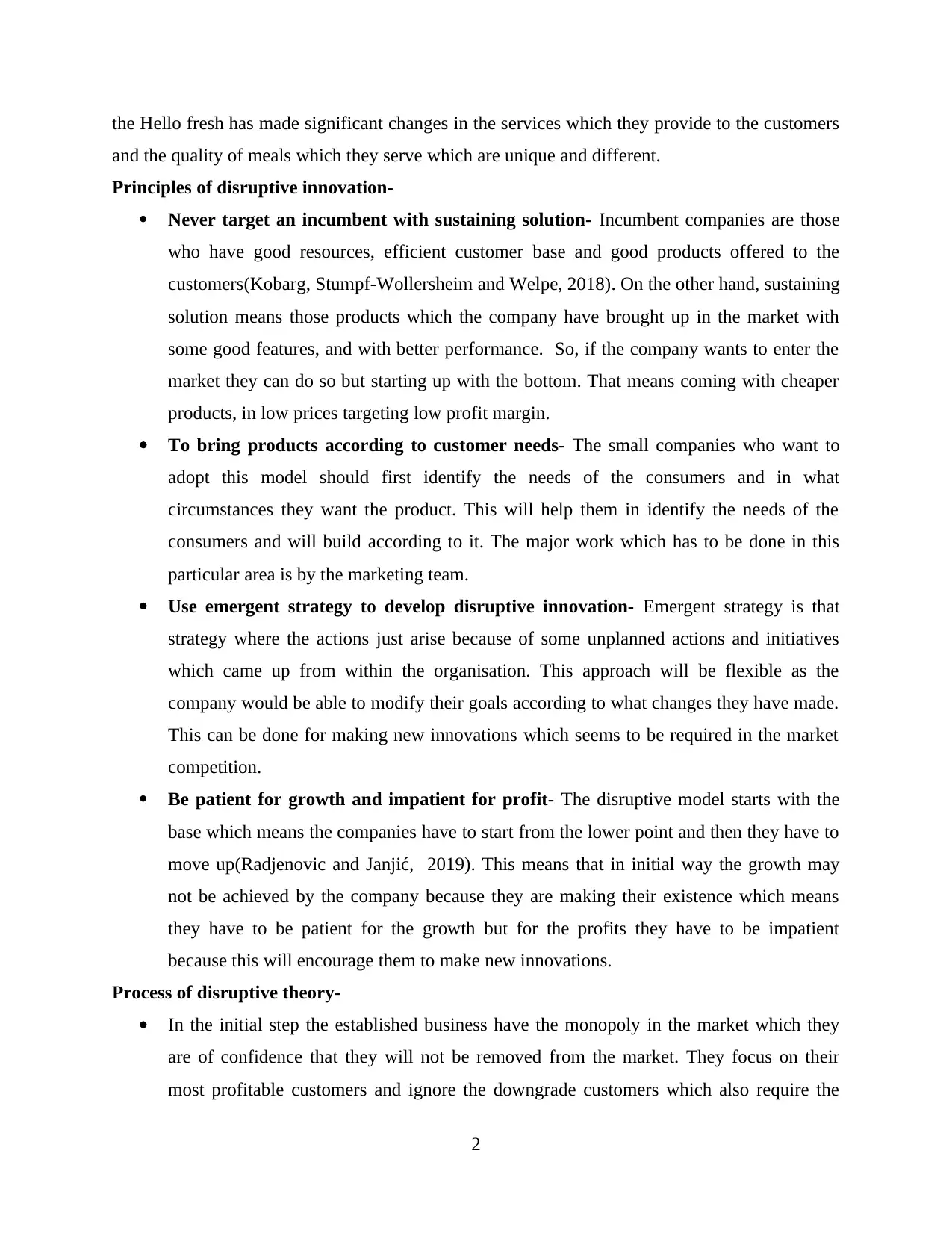
the Hello fresh has made significant changes in the services which they provide to the customers
and the quality of meals which they serve which are unique and different.
Principles of disruptive innovation-
Never target an incumbent with sustaining solution- Incumbent companies are those
who have good resources, efficient customer base and good products offered to the
customers(Kobarg, Stumpf-Wollersheim and Welpe, 2018). On the other hand, sustaining
solution means those products which the company have brought up in the market with
some good features, and with better performance. So, if the company wants to enter the
market they can do so but starting up with the bottom. That means coming with cheaper
products, in low prices targeting low profit margin.
To bring products according to customer needs- The small companies who want to
adopt this model should first identify the needs of the consumers and in what
circumstances they want the product. This will help them in identify the needs of the
consumers and will build according to it. The major work which has to be done in this
particular area is by the marketing team.
Use emergent strategy to develop disruptive innovation- Emergent strategy is that
strategy where the actions just arise because of some unplanned actions and initiatives
which came up from within the organisation. This approach will be flexible as the
company would be able to modify their goals according to what changes they have made.
This can be done for making new innovations which seems to be required in the market
competition.
Be patient for growth and impatient for profit- The disruptive model starts with the
base which means the companies have to start from the lower point and then they have to
move up(Radjenovic and Janjić, 2019). This means that in initial way the growth may
not be achieved by the company because they are making their existence which means
they have to be patient for the growth but for the profits they have to be impatient
because this will encourage them to make new innovations.
Process of disruptive theory-
In the initial step the established business have the monopoly in the market which they
are of confidence that they will not be removed from the market. They focus on their
most profitable customers and ignore the downgrade customers which also require the
2
and the quality of meals which they serve which are unique and different.
Principles of disruptive innovation-
Never target an incumbent with sustaining solution- Incumbent companies are those
who have good resources, efficient customer base and good products offered to the
customers(Kobarg, Stumpf-Wollersheim and Welpe, 2018). On the other hand, sustaining
solution means those products which the company have brought up in the market with
some good features, and with better performance. So, if the company wants to enter the
market they can do so but starting up with the bottom. That means coming with cheaper
products, in low prices targeting low profit margin.
To bring products according to customer needs- The small companies who want to
adopt this model should first identify the needs of the consumers and in what
circumstances they want the product. This will help them in identify the needs of the
consumers and will build according to it. The major work which has to be done in this
particular area is by the marketing team.
Use emergent strategy to develop disruptive innovation- Emergent strategy is that
strategy where the actions just arise because of some unplanned actions and initiatives
which came up from within the organisation. This approach will be flexible as the
company would be able to modify their goals according to what changes they have made.
This can be done for making new innovations which seems to be required in the market
competition.
Be patient for growth and impatient for profit- The disruptive model starts with the
base which means the companies have to start from the lower point and then they have to
move up(Radjenovic and Janjić, 2019). This means that in initial way the growth may
not be achieved by the company because they are making their existence which means
they have to be patient for the growth but for the profits they have to be impatient
because this will encourage them to make new innovations.
Process of disruptive theory-
In the initial step the established business have the monopoly in the market which they
are of confidence that they will not be removed from the market. They focus on their
most profitable customers and ignore the downgrade customers which also require the
2
Paraphrase This Document
Need a fresh take? Get an instant paraphrase of this document with our AI Paraphraser
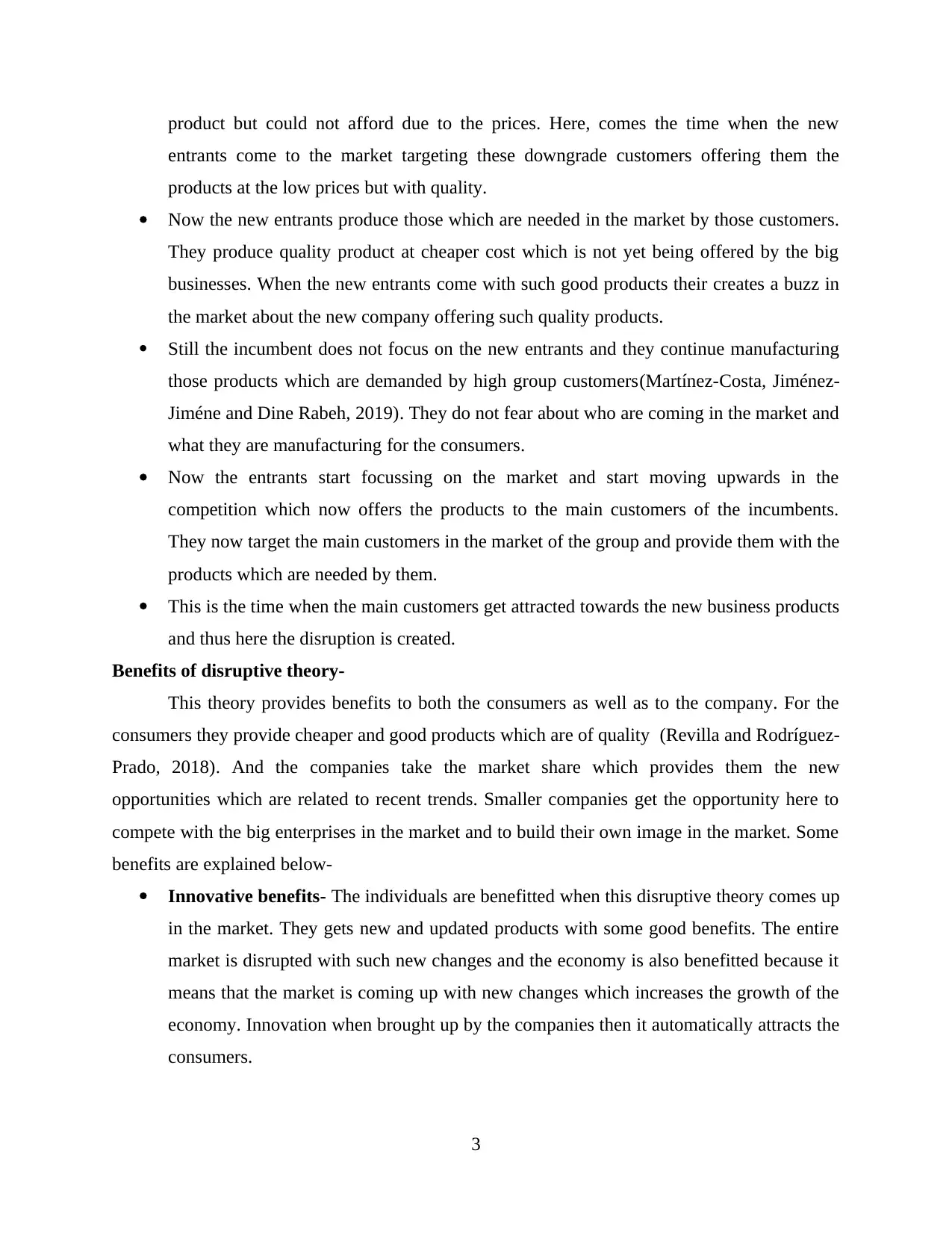
product but could not afford due to the prices. Here, comes the time when the new
entrants come to the market targeting these downgrade customers offering them the
products at the low prices but with quality.
Now the new entrants produce those which are needed in the market by those customers.
They produce quality product at cheaper cost which is not yet being offered by the big
businesses. When the new entrants come with such good products their creates a buzz in
the market about the new company offering such quality products.
Still the incumbent does not focus on the new entrants and they continue manufacturing
those products which are demanded by high group customers(Martínez-Costa, Jiménez-
Jiméne and Dine Rabeh, 2019). They do not fear about who are coming in the market and
what they are manufacturing for the consumers.
Now the entrants start focussing on the market and start moving upwards in the
competition which now offers the products to the main customers of the incumbents.
They now target the main customers in the market of the group and provide them with the
products which are needed by them.
This is the time when the main customers get attracted towards the new business products
and thus here the disruption is created.
Benefits of disruptive theory-
This theory provides benefits to both the consumers as well as to the company. For the
consumers they provide cheaper and good products which are of quality (Revilla and Rodríguez-
Prado, 2018). And the companies take the market share which provides them the new
opportunities which are related to recent trends. Smaller companies get the opportunity here to
compete with the big enterprises in the market and to build their own image in the market. Some
benefits are explained below-
Innovative benefits- The individuals are benefitted when this disruptive theory comes up
in the market. They gets new and updated products with some good benefits. The entire
market is disrupted with such new changes and the economy is also benefitted because it
means that the market is coming up with new changes which increases the growth of the
economy. Innovation when brought up by the companies then it automatically attracts the
consumers.
3
entrants come to the market targeting these downgrade customers offering them the
products at the low prices but with quality.
Now the new entrants produce those which are needed in the market by those customers.
They produce quality product at cheaper cost which is not yet being offered by the big
businesses. When the new entrants come with such good products their creates a buzz in
the market about the new company offering such quality products.
Still the incumbent does not focus on the new entrants and they continue manufacturing
those products which are demanded by high group customers(Martínez-Costa, Jiménez-
Jiméne and Dine Rabeh, 2019). They do not fear about who are coming in the market and
what they are manufacturing for the consumers.
Now the entrants start focussing on the market and start moving upwards in the
competition which now offers the products to the main customers of the incumbents.
They now target the main customers in the market of the group and provide them with the
products which are needed by them.
This is the time when the main customers get attracted towards the new business products
and thus here the disruption is created.
Benefits of disruptive theory-
This theory provides benefits to both the consumers as well as to the company. For the
consumers they provide cheaper and good products which are of quality (Revilla and Rodríguez-
Prado, 2018). And the companies take the market share which provides them the new
opportunities which are related to recent trends. Smaller companies get the opportunity here to
compete with the big enterprises in the market and to build their own image in the market. Some
benefits are explained below-
Innovative benefits- The individuals are benefitted when this disruptive theory comes up
in the market. They gets new and updated products with some good benefits. The entire
market is disrupted with such new changes and the economy is also benefitted because it
means that the market is coming up with new changes which increases the growth of the
economy. Innovation when brought up by the companies then it automatically attracts the
consumers.
3
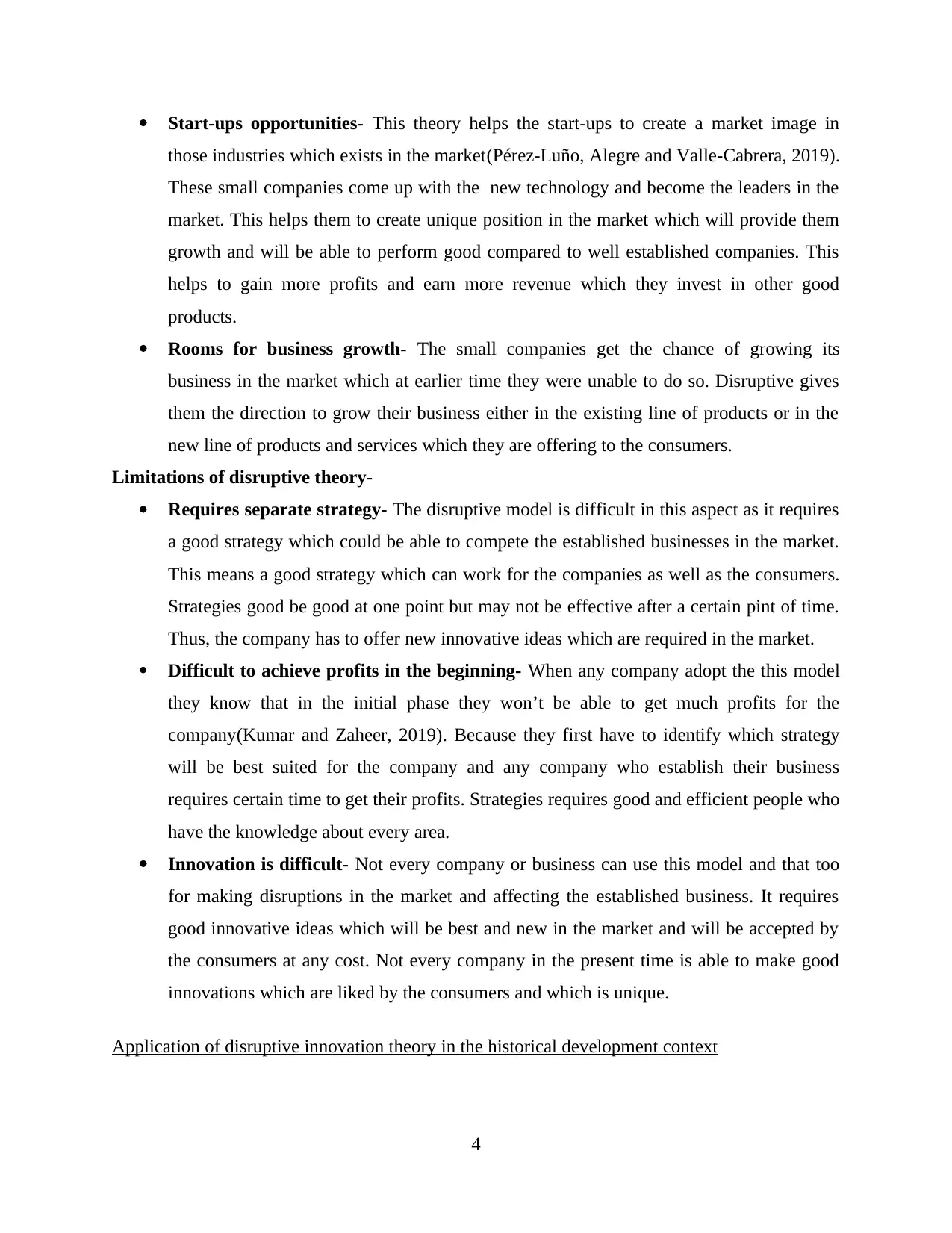
Start-ups opportunities- This theory helps the start-ups to create a market image in
those industries which exists in the market(Pérez-Luño, Alegre and Valle-Cabrera, 2019).
These small companies come up with the new technology and become the leaders in the
market. This helps them to create unique position in the market which will provide them
growth and will be able to perform good compared to well established companies. This
helps to gain more profits and earn more revenue which they invest in other good
products.
Rooms for business growth- The small companies get the chance of growing its
business in the market which at earlier time they were unable to do so. Disruptive gives
them the direction to grow their business either in the existing line of products or in the
new line of products and services which they are offering to the consumers.
Limitations of disruptive theory-
Requires separate strategy- The disruptive model is difficult in this aspect as it requires
a good strategy which could be able to compete the established businesses in the market.
This means a good strategy which can work for the companies as well as the consumers.
Strategies good be good at one point but may not be effective after a certain pint of time.
Thus, the company has to offer new innovative ideas which are required in the market.
Difficult to achieve profits in the beginning- When any company adopt the this model
they know that in the initial phase they won’t be able to get much profits for the
company(Kumar and Zaheer, 2019). Because they first have to identify which strategy
will be best suited for the company and any company who establish their business
requires certain time to get their profits. Strategies requires good and efficient people who
have the knowledge about every area.
Innovation is difficult- Not every company or business can use this model and that too
for making disruptions in the market and affecting the established business. It requires
good innovative ideas which will be best and new in the market and will be accepted by
the consumers at any cost. Not every company in the present time is able to make good
innovations which are liked by the consumers and which is unique.
Application of disruptive innovation theory in the historical development context
4
those industries which exists in the market(Pérez-Luño, Alegre and Valle-Cabrera, 2019).
These small companies come up with the new technology and become the leaders in the
market. This helps them to create unique position in the market which will provide them
growth and will be able to perform good compared to well established companies. This
helps to gain more profits and earn more revenue which they invest in other good
products.
Rooms for business growth- The small companies get the chance of growing its
business in the market which at earlier time they were unable to do so. Disruptive gives
them the direction to grow their business either in the existing line of products or in the
new line of products and services which they are offering to the consumers.
Limitations of disruptive theory-
Requires separate strategy- The disruptive model is difficult in this aspect as it requires
a good strategy which could be able to compete the established businesses in the market.
This means a good strategy which can work for the companies as well as the consumers.
Strategies good be good at one point but may not be effective after a certain pint of time.
Thus, the company has to offer new innovative ideas which are required in the market.
Difficult to achieve profits in the beginning- When any company adopt the this model
they know that in the initial phase they won’t be able to get much profits for the
company(Kumar and Zaheer, 2019). Because they first have to identify which strategy
will be best suited for the company and any company who establish their business
requires certain time to get their profits. Strategies requires good and efficient people who
have the knowledge about every area.
Innovation is difficult- Not every company or business can use this model and that too
for making disruptions in the market and affecting the established business. It requires
good innovative ideas which will be best and new in the market and will be accepted by
the consumers at any cost. Not every company in the present time is able to make good
innovations which are liked by the consumers and which is unique.
Application of disruptive innovation theory in the historical development context
4
⊘ This is a preview!⊘
Do you want full access?
Subscribe today to unlock all pages.

Trusted by 1+ million students worldwide
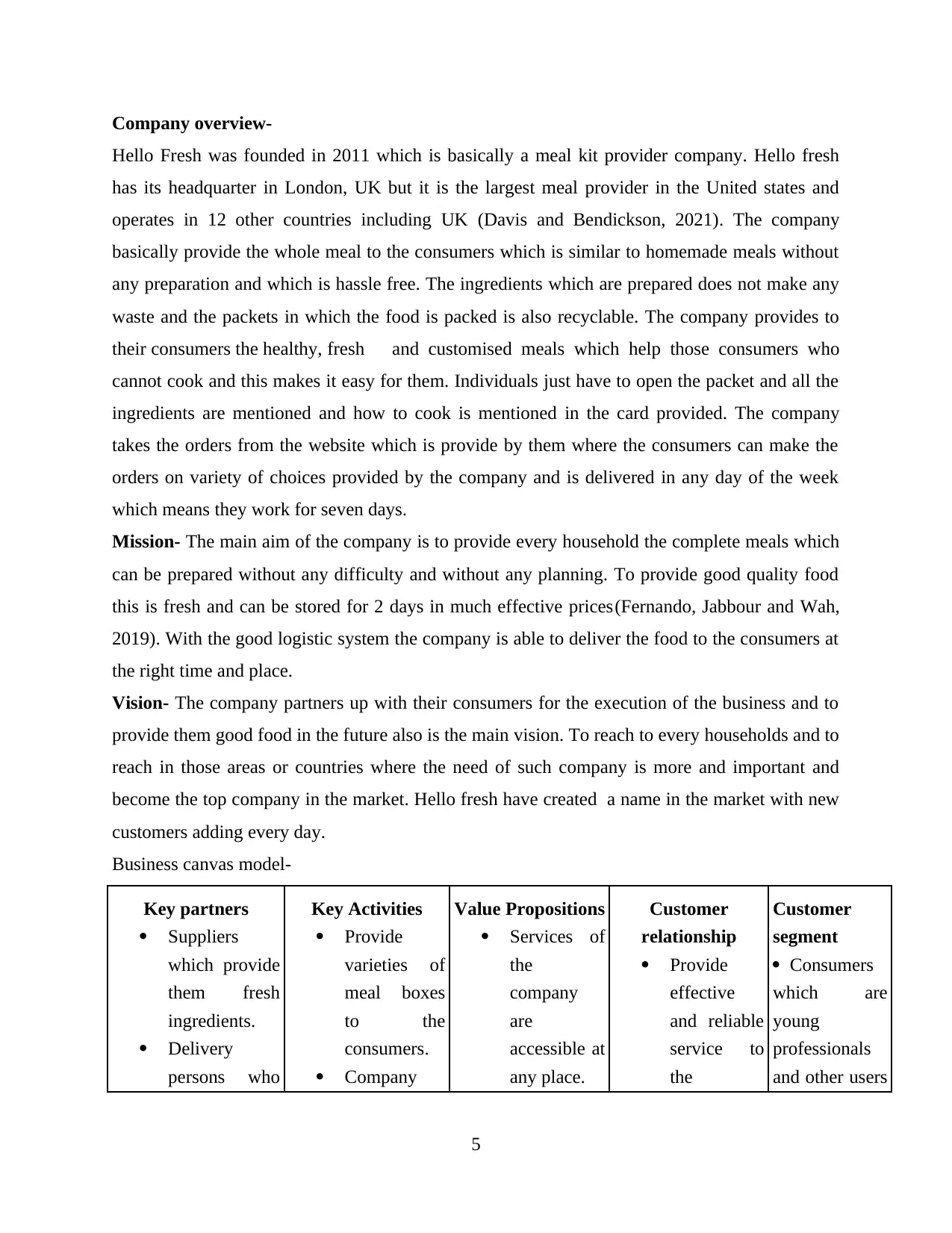
Company overview-
Hello Fresh was founded in 2011 which is basically a meal kit provider company. Hello fresh
has its headquarter in London, UK but it is the largest meal provider in the United states and
operates in 12 other countries including UK (Davis and Bendickson, 2021). The company
basically provide the whole meal to the consumers which is similar to homemade meals without
any preparation and which is hassle free. The ingredients which are prepared does not make any
waste and the packets in which the food is packed is also recyclable. The company provides to
their consumers the healthy, fresh and customised meals which help those consumers who
cannot cook and this makes it easy for them. Individuals just have to open the packet and all the
ingredients are mentioned and how to cook is mentioned in the card provided. The company
takes the orders from the website which is provide by them where the consumers can make the
orders on variety of choices provided by the company and is delivered in any day of the week
which means they work for seven days.
Mission- The main aim of the company is to provide every household the complete meals which
can be prepared without any difficulty and without any planning. To provide good quality food
this is fresh and can be stored for 2 days in much effective prices(Fernando, Jabbour and Wah,
2019). With the good logistic system the company is able to deliver the food to the consumers at
the right time and place.
Vision- The company partners up with their consumers for the execution of the business and to
provide them good food in the future also is the main vision. To reach to every households and to
reach in those areas or countries where the need of such company is more and important and
become the top company in the market. Hello fresh have created a name in the market with new
customers adding every day.
Business canvas model-
Key partners
Suppliers
which provide
them fresh
ingredients.
Delivery
persons who
Key Activities
Provide
varieties of
meal boxes
to the
consumers.
Company
Value Propositions
Services of
the
company
are
accessible at
any place.
Customer
relationship
Provide
effective
and reliable
service to
the
Customer
segment
Consumers
which are
young
professionals
and other users
5
Hello Fresh was founded in 2011 which is basically a meal kit provider company. Hello fresh
has its headquarter in London, UK but it is the largest meal provider in the United states and
operates in 12 other countries including UK (Davis and Bendickson, 2021). The company
basically provide the whole meal to the consumers which is similar to homemade meals without
any preparation and which is hassle free. The ingredients which are prepared does not make any
waste and the packets in which the food is packed is also recyclable. The company provides to
their consumers the healthy, fresh and customised meals which help those consumers who
cannot cook and this makes it easy for them. Individuals just have to open the packet and all the
ingredients are mentioned and how to cook is mentioned in the card provided. The company
takes the orders from the website which is provide by them where the consumers can make the
orders on variety of choices provided by the company and is delivered in any day of the week
which means they work for seven days.
Mission- The main aim of the company is to provide every household the complete meals which
can be prepared without any difficulty and without any planning. To provide good quality food
this is fresh and can be stored for 2 days in much effective prices(Fernando, Jabbour and Wah,
2019). With the good logistic system the company is able to deliver the food to the consumers at
the right time and place.
Vision- The company partners up with their consumers for the execution of the business and to
provide them good food in the future also is the main vision. To reach to every households and to
reach in those areas or countries where the need of such company is more and important and
become the top company in the market. Hello fresh have created a name in the market with new
customers adding every day.
Business canvas model-
Key partners
Suppliers
which provide
them fresh
ingredients.
Delivery
persons who
Key Activities
Provide
varieties of
meal boxes
to the
consumers.
Company
Value Propositions
Services of
the
company
are
accessible at
any place.
Customer
relationship
Provide
effective
and reliable
service to
the
Customer
segment
Consumers
which are
young
professionals
and other users
5
Paraphrase This Document
Need a fresh take? Get an instant paraphrase of this document with our AI Paraphraser
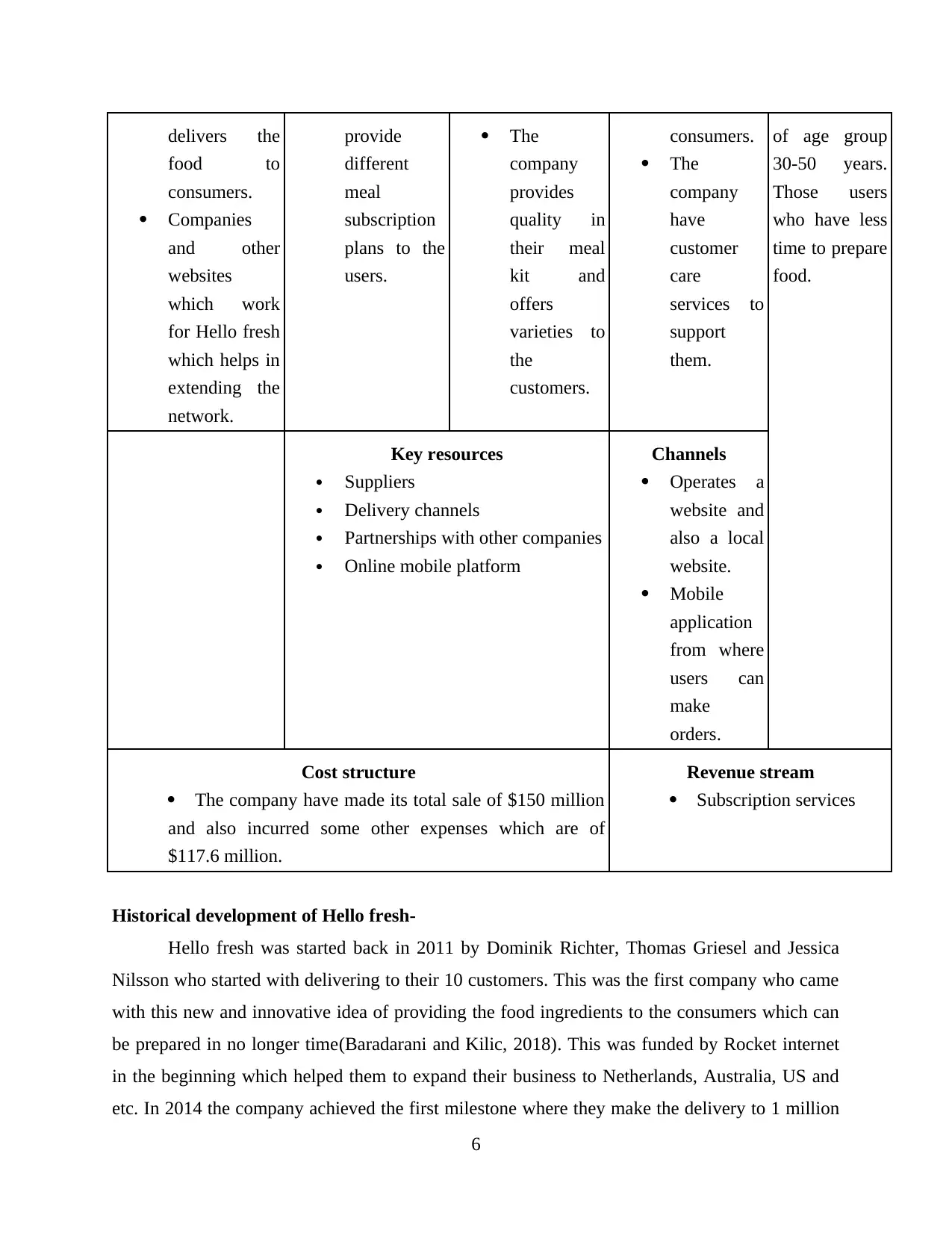
delivers the
food to
consumers.
Companies
and other
websites
which work
for Hello fresh
which helps in
extending the
network.
provide
different
meal
subscription
plans to the
users.
The
company
provides
quality in
their meal
kit and
offers
varieties to
the
customers.
consumers.
The
company
have
customer
care
services to
support
them.
of age group
30-50 years.
Those users
who have less
time to prepare
food.
Key resources
Suppliers
Delivery channels
Partnerships with other companies
Online mobile platform
Channels
Operates a
website and
also a local
website.
Mobile
application
from where
users can
make
orders.
Cost structure
The company have made its total sale of $150 million
and also incurred some other expenses which are of
$117.6 million.
Revenue stream
Subscription services
Historical development of Hello fresh-
Hello fresh was started back in 2011 by Dominik Richter, Thomas Griesel and Jessica
Nilsson who started with delivering to their 10 customers. This was the first company who came
with this new and innovative idea of providing the food ingredients to the consumers which can
be prepared in no longer time(Baradarani and Kilic, 2018). This was funded by Rocket internet
in the beginning which helped them to expand their business to Netherlands, Australia, US and
etc. In 2014 the company achieved the first milestone where they make the delivery to 1 million
6
food to
consumers.
Companies
and other
websites
which work
for Hello fresh
which helps in
extending the
network.
provide
different
meal
subscription
plans to the
users.
The
company
provides
quality in
their meal
kit and
offers
varieties to
the
customers.
consumers.
The
company
have
customer
care
services to
support
them.
of age group
30-50 years.
Those users
who have less
time to prepare
food.
Key resources
Suppliers
Delivery channels
Partnerships with other companies
Online mobile platform
Channels
Operates a
website and
also a local
website.
Mobile
application
from where
users can
make
orders.
Cost structure
The company have made its total sale of $150 million
and also incurred some other expenses which are of
$117.6 million.
Revenue stream
Subscription services
Historical development of Hello fresh-
Hello fresh was started back in 2011 by Dominik Richter, Thomas Griesel and Jessica
Nilsson who started with delivering to their 10 customers. This was the first company who came
with this new and innovative idea of providing the food ingredients to the consumers which can
be prepared in no longer time(Baradarani and Kilic, 2018). This was funded by Rocket internet
in the beginning which helped them to expand their business to Netherlands, Australia, US and
etc. In 2014 the company achieved the first milestone where they make the delivery to 1 million
6
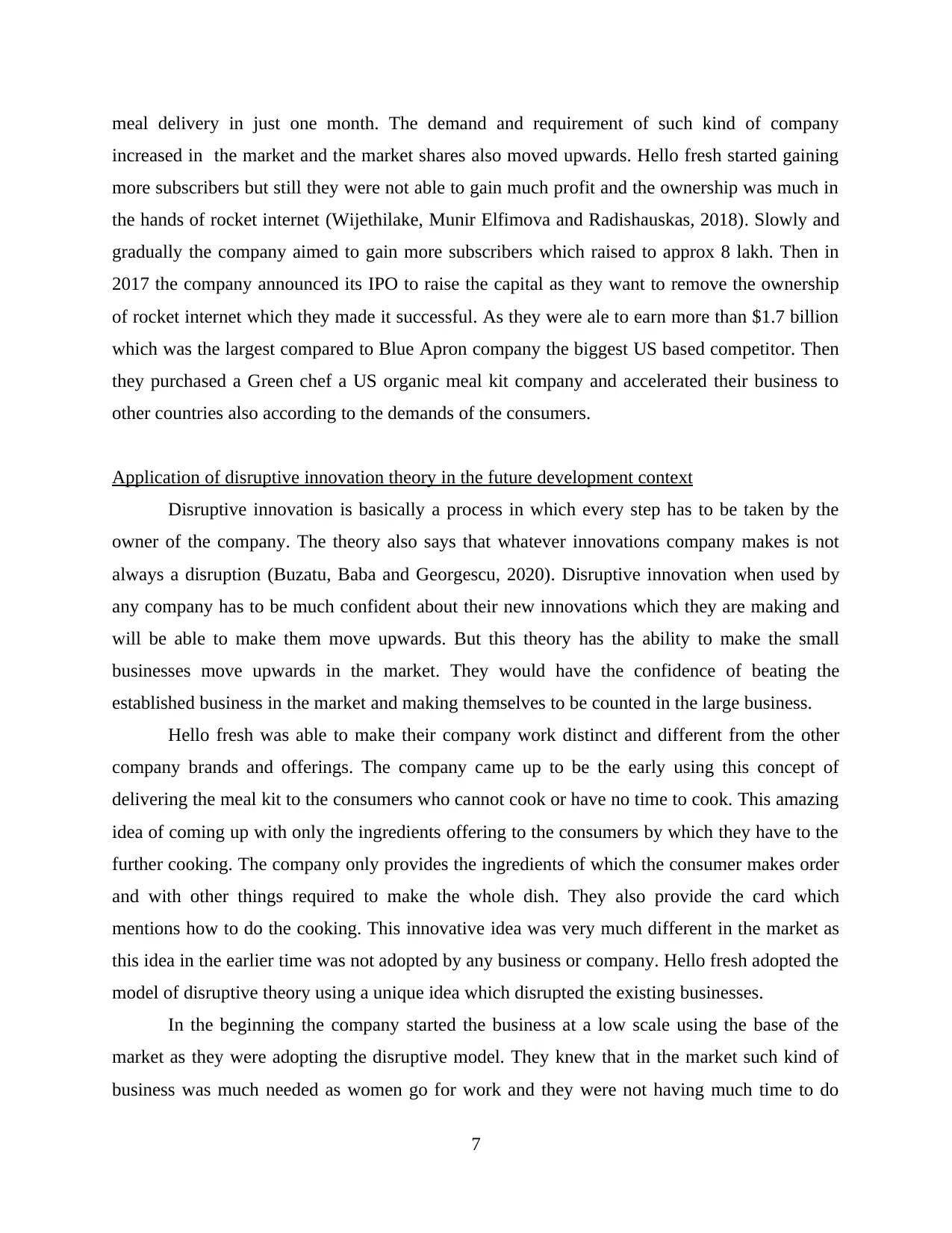
meal delivery in just one month. The demand and requirement of such kind of company
increased in the market and the market shares also moved upwards. Hello fresh started gaining
more subscribers but still they were not able to gain much profit and the ownership was much in
the hands of rocket internet (Wijethilake, Munir Elfimova and Radishauskas, 2018). Slowly and
gradually the company aimed to gain more subscribers which raised to approx 8 lakh. Then in
2017 the company announced its IPO to raise the capital as they want to remove the ownership
of rocket internet which they made it successful. As they were ale to earn more than $1.7 billion
which was the largest compared to Blue Apron company the biggest US based competitor. Then
they purchased a Green chef a US organic meal kit company and accelerated their business to
other countries also according to the demands of the consumers.
Application of disruptive innovation theory in the future development context
Disruptive innovation is basically a process in which every step has to be taken by the
owner of the company. The theory also says that whatever innovations company makes is not
always a disruption (Buzatu, Baba and Georgescu, 2020). Disruptive innovation when used by
any company has to be much confident about their new innovations which they are making and
will be able to make them move upwards. But this theory has the ability to make the small
businesses move upwards in the market. They would have the confidence of beating the
established business in the market and making themselves to be counted in the large business.
Hello fresh was able to make their company work distinct and different from the other
company brands and offerings. The company came up to be the early using this concept of
delivering the meal kit to the consumers who cannot cook or have no time to cook. This amazing
idea of coming up with only the ingredients offering to the consumers by which they have to the
further cooking. The company only provides the ingredients of which the consumer makes order
and with other things required to make the whole dish. They also provide the card which
mentions how to do the cooking. This innovative idea was very much different in the market as
this idea in the earlier time was not adopted by any business or company. Hello fresh adopted the
model of disruptive theory using a unique idea which disrupted the existing businesses.
In the beginning the company started the business at a low scale using the base of the
market as they were adopting the disruptive model. They knew that in the market such kind of
business was much needed as women go for work and they were not having much time to do
7
increased in the market and the market shares also moved upwards. Hello fresh started gaining
more subscribers but still they were not able to gain much profit and the ownership was much in
the hands of rocket internet (Wijethilake, Munir Elfimova and Radishauskas, 2018). Slowly and
gradually the company aimed to gain more subscribers which raised to approx 8 lakh. Then in
2017 the company announced its IPO to raise the capital as they want to remove the ownership
of rocket internet which they made it successful. As they were ale to earn more than $1.7 billion
which was the largest compared to Blue Apron company the biggest US based competitor. Then
they purchased a Green chef a US organic meal kit company and accelerated their business to
other countries also according to the demands of the consumers.
Application of disruptive innovation theory in the future development context
Disruptive innovation is basically a process in which every step has to be taken by the
owner of the company. The theory also says that whatever innovations company makes is not
always a disruption (Buzatu, Baba and Georgescu, 2020). Disruptive innovation when used by
any company has to be much confident about their new innovations which they are making and
will be able to make them move upwards. But this theory has the ability to make the small
businesses move upwards in the market. They would have the confidence of beating the
established business in the market and making themselves to be counted in the large business.
Hello fresh was able to make their company work distinct and different from the other
company brands and offerings. The company came up to be the early using this concept of
delivering the meal kit to the consumers who cannot cook or have no time to cook. This amazing
idea of coming up with only the ingredients offering to the consumers by which they have to the
further cooking. The company only provides the ingredients of which the consumer makes order
and with other things required to make the whole dish. They also provide the card which
mentions how to do the cooking. This innovative idea was very much different in the market as
this idea in the earlier time was not adopted by any business or company. Hello fresh adopted the
model of disruptive theory using a unique idea which disrupted the existing businesses.
In the beginning the company started the business at a low scale using the base of the
market as they were adopting the disruptive model. They knew that in the market such kind of
business was much needed as women go for work and they were not having much time to do
7
⊘ This is a preview!⊘
Do you want full access?
Subscribe today to unlock all pages.

Trusted by 1+ million students worldwide
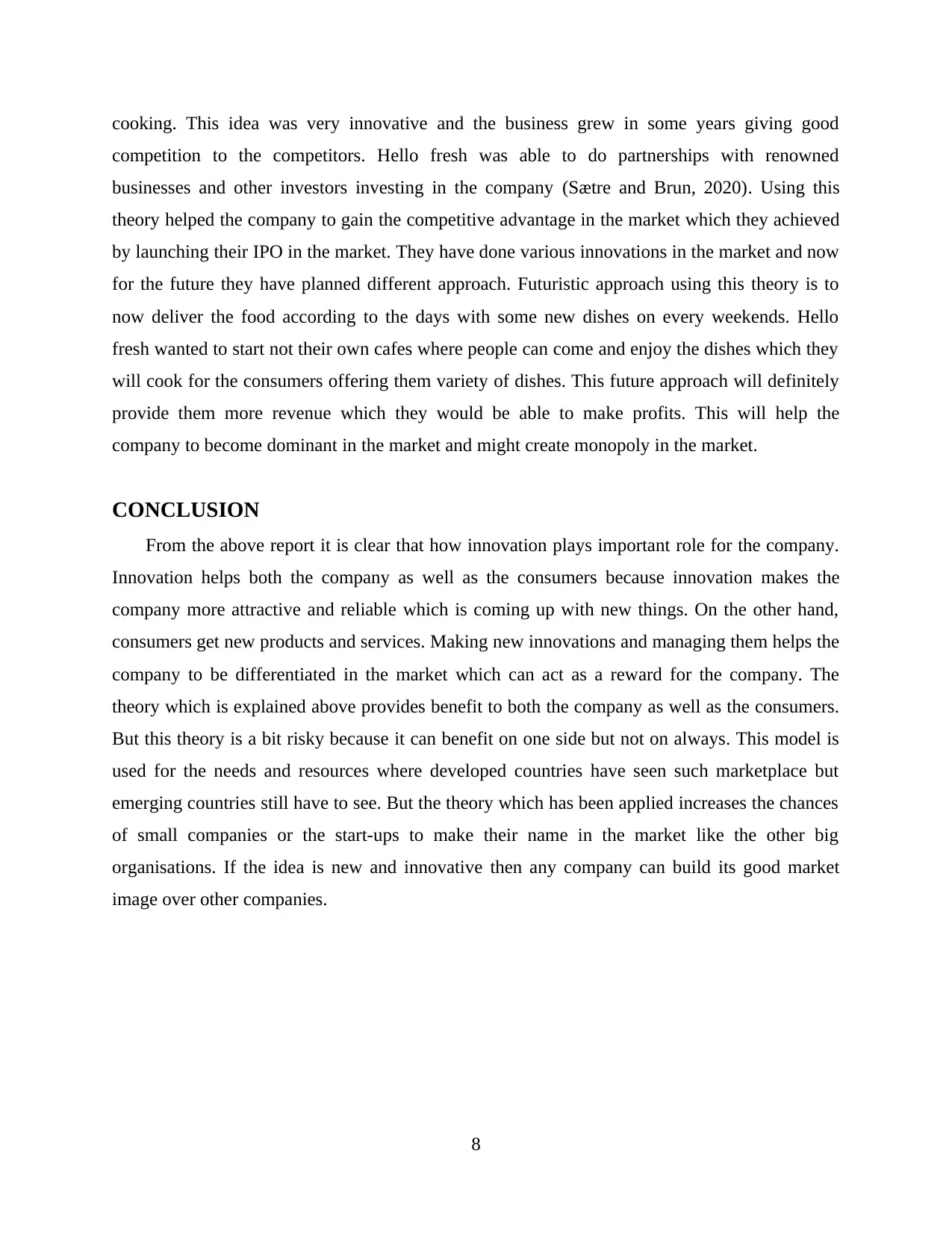
cooking. This idea was very innovative and the business grew in some years giving good
competition to the competitors. Hello fresh was able to do partnerships with renowned
businesses and other investors investing in the company (Sætre and Brun, 2020). Using this
theory helped the company to gain the competitive advantage in the market which they achieved
by launching their IPO in the market. They have done various innovations in the market and now
for the future they have planned different approach. Futuristic approach using this theory is to
now deliver the food according to the days with some new dishes on every weekends. Hello
fresh wanted to start not their own cafes where people can come and enjoy the dishes which they
will cook for the consumers offering them variety of dishes. This future approach will definitely
provide them more revenue which they would be able to make profits. This will help the
company to become dominant in the market and might create monopoly in the market.
CONCLUSION
From the above report it is clear that how innovation plays important role for the company.
Innovation helps both the company as well as the consumers because innovation makes the
company more attractive and reliable which is coming up with new things. On the other hand,
consumers get new products and services. Making new innovations and managing them helps the
company to be differentiated in the market which can act as a reward for the company. The
theory which is explained above provides benefit to both the company as well as the consumers.
But this theory is a bit risky because it can benefit on one side but not on always. This model is
used for the needs and resources where developed countries have seen such marketplace but
emerging countries still have to see. But the theory which has been applied increases the chances
of small companies or the start-ups to make their name in the market like the other big
organisations. If the idea is new and innovative then any company can build its good market
image over other companies.
8
competition to the competitors. Hello fresh was able to do partnerships with renowned
businesses and other investors investing in the company (Sætre and Brun, 2020). Using this
theory helped the company to gain the competitive advantage in the market which they achieved
by launching their IPO in the market. They have done various innovations in the market and now
for the future they have planned different approach. Futuristic approach using this theory is to
now deliver the food according to the days with some new dishes on every weekends. Hello
fresh wanted to start not their own cafes where people can come and enjoy the dishes which they
will cook for the consumers offering them variety of dishes. This future approach will definitely
provide them more revenue which they would be able to make profits. This will help the
company to become dominant in the market and might create monopoly in the market.
CONCLUSION
From the above report it is clear that how innovation plays important role for the company.
Innovation helps both the company as well as the consumers because innovation makes the
company more attractive and reliable which is coming up with new things. On the other hand,
consumers get new products and services. Making new innovations and managing them helps the
company to be differentiated in the market which can act as a reward for the company. The
theory which is explained above provides benefit to both the company as well as the consumers.
But this theory is a bit risky because it can benefit on one side but not on always. This model is
used for the needs and resources where developed countries have seen such marketplace but
emerging countries still have to see. But the theory which has been applied increases the chances
of small companies or the start-ups to make their name in the market like the other big
organisations. If the idea is new and innovative then any company can build its good market
image over other companies.
8
Paraphrase This Document
Need a fresh take? Get an instant paraphrase of this document with our AI Paraphraser
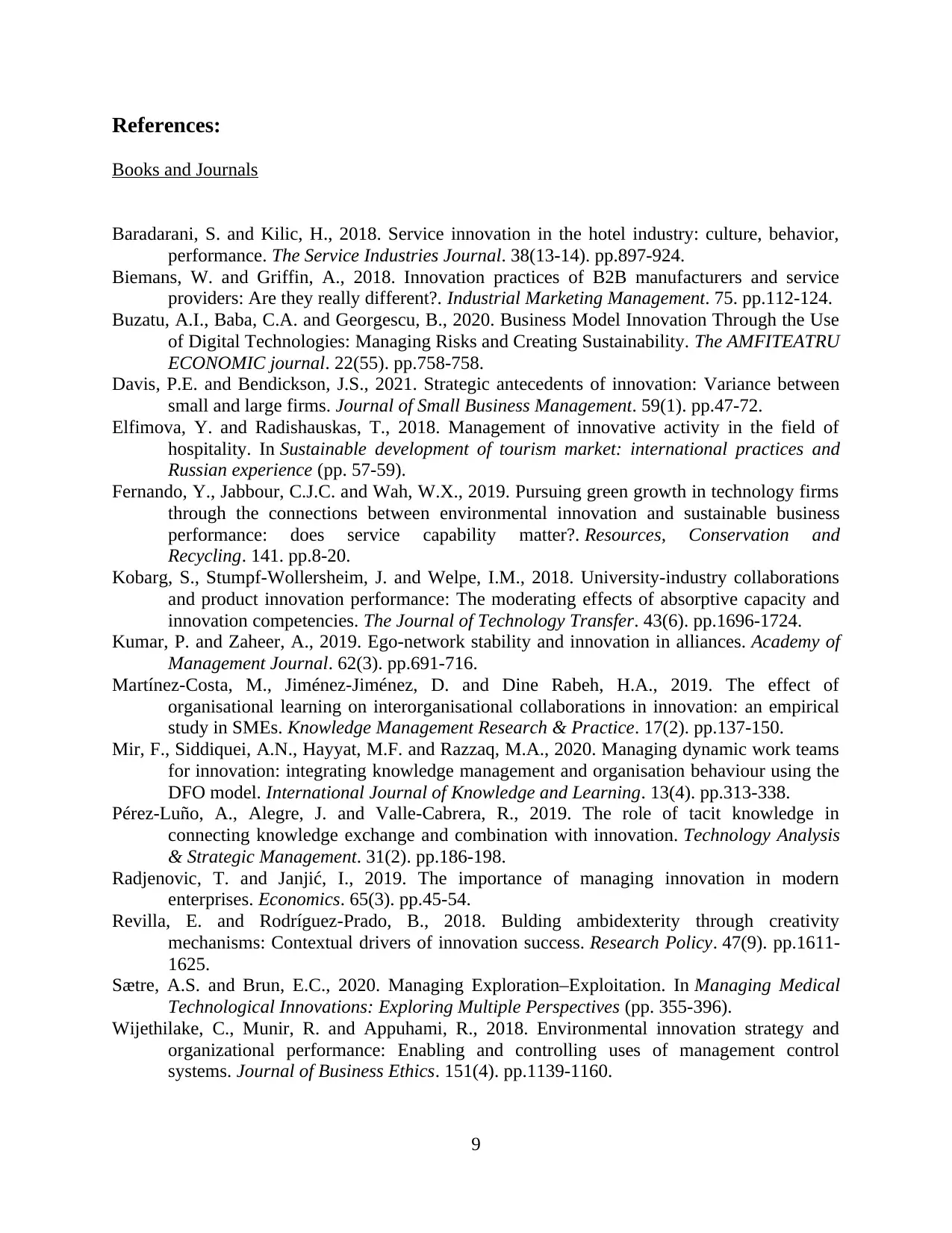
References:
Books and Journals
Baradarani, S. and Kilic, H., 2018. Service innovation in the hotel industry: culture, behavior,
performance. The Service Industries Journal. 38(13-14). pp.897-924.
Biemans, W. and Griffin, A., 2018. Innovation practices of B2B manufacturers and service
providers: Are they really different?. Industrial Marketing Management. 75. pp.112-124.
Buzatu, A.I., Baba, C.A. and Georgescu, B., 2020. Business Model Innovation Through the Use
of Digital Technologies: Managing Risks and Creating Sustainability. The AMFITEATRU
ECONOMIC journal. 22(55). pp.758-758.
Davis, P.E. and Bendickson, J.S., 2021. Strategic antecedents of innovation: Variance between
small and large firms. Journal of Small Business Management. 59(1). pp.47-72.
Elfimova, Y. and Radishauskas, T., 2018. Management of innovative activity in the field of
hospitality. In Sustainable development of tourism market: international practices and
Russian experience (pp. 57-59).
Fernando, Y., Jabbour, C.J.C. and Wah, W.X., 2019. Pursuing green growth in technology firms
through the connections between environmental innovation and sustainable business
performance: does service capability matter?. Resources, Conservation and
Recycling. 141. pp.8-20.
Kobarg, S., Stumpf-Wollersheim, J. and Welpe, I.M., 2018. University-industry collaborations
and product innovation performance: The moderating effects of absorptive capacity and
innovation competencies. The Journal of Technology Transfer. 43(6). pp.1696-1724.
Kumar, P. and Zaheer, A., 2019. Ego-network stability and innovation in alliances. Academy of
Management Journal. 62(3). pp.691-716.
Martínez-Costa, M., Jiménez-Jiménez, D. and Dine Rabeh, H.A., 2019. The effect of
organisational learning on interorganisational collaborations in innovation: an empirical
study in SMEs. Knowledge Management Research & Practice. 17(2). pp.137-150.
Mir, F., Siddiquei, A.N., Hayyat, M.F. and Razzaq, M.A., 2020. Managing dynamic work teams
for innovation: integrating knowledge management and organisation behaviour using the
DFO model. International Journal of Knowledge and Learning. 13(4). pp.313-338.
Pérez-Luño, A., Alegre, J. and Valle-Cabrera, R., 2019. The role of tacit knowledge in
connecting knowledge exchange and combination with innovation. Technology Analysis
& Strategic Management. 31(2). pp.186-198.
Radjenovic, T. and Janjić, I., 2019. The importance of managing innovation in modern
enterprises. Economics. 65(3). pp.45-54.
Revilla, E. and Rodríguez-Prado, B., 2018. Bulding ambidexterity through creativity
mechanisms: Contextual drivers of innovation success. Research Policy. 47(9). pp.1611-
1625.
Sætre, A.S. and Brun, E.C., 2020. Managing Exploration–Exploitation. In Managing Medical
Technological Innovations: Exploring Multiple Perspectives (pp. 355-396).
Wijethilake, C., Munir, R. and Appuhami, R., 2018. Environmental innovation strategy and
organizational performance: Enabling and controlling uses of management control
systems. Journal of Business Ethics. 151(4). pp.1139-1160.
9
Books and Journals
Baradarani, S. and Kilic, H., 2018. Service innovation in the hotel industry: culture, behavior,
performance. The Service Industries Journal. 38(13-14). pp.897-924.
Biemans, W. and Griffin, A., 2018. Innovation practices of B2B manufacturers and service
providers: Are they really different?. Industrial Marketing Management. 75. pp.112-124.
Buzatu, A.I., Baba, C.A. and Georgescu, B., 2020. Business Model Innovation Through the Use
of Digital Technologies: Managing Risks and Creating Sustainability. The AMFITEATRU
ECONOMIC journal. 22(55). pp.758-758.
Davis, P.E. and Bendickson, J.S., 2021. Strategic antecedents of innovation: Variance between
small and large firms. Journal of Small Business Management. 59(1). pp.47-72.
Elfimova, Y. and Radishauskas, T., 2018. Management of innovative activity in the field of
hospitality. In Sustainable development of tourism market: international practices and
Russian experience (pp. 57-59).
Fernando, Y., Jabbour, C.J.C. and Wah, W.X., 2019. Pursuing green growth in technology firms
through the connections between environmental innovation and sustainable business
performance: does service capability matter?. Resources, Conservation and
Recycling. 141. pp.8-20.
Kobarg, S., Stumpf-Wollersheim, J. and Welpe, I.M., 2018. University-industry collaborations
and product innovation performance: The moderating effects of absorptive capacity and
innovation competencies. The Journal of Technology Transfer. 43(6). pp.1696-1724.
Kumar, P. and Zaheer, A., 2019. Ego-network stability and innovation in alliances. Academy of
Management Journal. 62(3). pp.691-716.
Martínez-Costa, M., Jiménez-Jiménez, D. and Dine Rabeh, H.A., 2019. The effect of
organisational learning on interorganisational collaborations in innovation: an empirical
study in SMEs. Knowledge Management Research & Practice. 17(2). pp.137-150.
Mir, F., Siddiquei, A.N., Hayyat, M.F. and Razzaq, M.A., 2020. Managing dynamic work teams
for innovation: integrating knowledge management and organisation behaviour using the
DFO model. International Journal of Knowledge and Learning. 13(4). pp.313-338.
Pérez-Luño, A., Alegre, J. and Valle-Cabrera, R., 2019. The role of tacit knowledge in
connecting knowledge exchange and combination with innovation. Technology Analysis
& Strategic Management. 31(2). pp.186-198.
Radjenovic, T. and Janjić, I., 2019. The importance of managing innovation in modern
enterprises. Economics. 65(3). pp.45-54.
Revilla, E. and Rodríguez-Prado, B., 2018. Bulding ambidexterity through creativity
mechanisms: Contextual drivers of innovation success. Research Policy. 47(9). pp.1611-
1625.
Sætre, A.S. and Brun, E.C., 2020. Managing Exploration–Exploitation. In Managing Medical
Technological Innovations: Exploring Multiple Perspectives (pp. 355-396).
Wijethilake, C., Munir, R. and Appuhami, R., 2018. Environmental innovation strategy and
organizational performance: Enabling and controlling uses of management control
systems. Journal of Business Ethics. 151(4). pp.1139-1160.
9

10
⊘ This is a preview!⊘
Do you want full access?
Subscribe today to unlock all pages.

Trusted by 1+ million students worldwide
1 out of 12
Related Documents
Your All-in-One AI-Powered Toolkit for Academic Success.
+13062052269
info@desklib.com
Available 24*7 on WhatsApp / Email
![[object Object]](/_next/static/media/star-bottom.7253800d.svg)
Unlock your academic potential
Copyright © 2020–2025 A2Z Services. All Rights Reserved. Developed and managed by ZUCOL.




